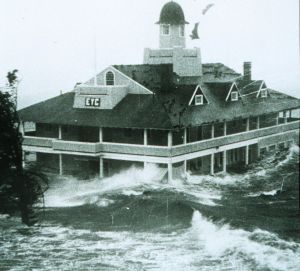Edgewood Yacht club in Carol’s storm surge
On August 31, 1954, Hurricane Carol delivered the left jab of a 1-2 punch to New England by hurricanes that year. Eleven days later, Hurricane Edna would strike the same area. A major hurricane, Carol was the worst hurricane to strike the area in the decade since the Great Atlantic Hurricane in 1944.
Carol was first detected as a strong tropical depression east of the central Bahamas. In this pre-satellite era, the disturbance from which the depression formed had gone largely unnoticed. It reached tropical-storm status withing six hours as it moved slowly northward. Within two days, it was a full hurricane. Carol slowed down as it zigged northwest then zagged northeastward. During this period, its sustained winds peaked at 115 mph (185 km/hr). While east of Cape Fear, Carol got caught up in a low-pressure trough heading off the U.S. east coast and picked up considerable forward speed, brushing Cape Hatteras with hurricane-force gusts. Within a day and a half, Carol slammed into Long Island and Connecticut, much like the Great New England hurricane sixteen years before. The winds had risen back up to 110 mph (190 km/hr) and Carol brought along a healthy slug of tropical rain.
 Carol’s winds destroyed tens of thousands of homes throughout New England as well as thousands of cars and as many boats. It ruined $22 million worth of crops, leveling apple and peach orchards. It also flattened thousands of power line poles, leaving 150,000 people without power. The damage totaled $460 million. The hurricane’s impact was so considerable that the Weather Bureau decided at year’s end to retire the name Carol (along with Edna and Hazel) for ten years. This makes Carol the first Atlantic hurricane name to be retired. The trio of Carol, Edna, and Hazel also prompted Congress to allocate funds for the Weather Bureau to form the National Hurricane Research Project and to create a network of technologically advance weather radars (WSR-57s) that was to improve monitoring of severe weather across the country in the decades to come.
Carol’s winds destroyed tens of thousands of homes throughout New England as well as thousands of cars and as many boats. It ruined $22 million worth of crops, leveling apple and peach orchards. It also flattened thousands of power line poles, leaving 150,000 people without power. The damage totaled $460 million. The hurricane’s impact was so considerable that the Weather Bureau decided at year’s end to retire the name Carol (along with Edna and Hazel) for ten years. This makes Carol the first Atlantic hurricane name to be retired. The trio of Carol, Edna, and Hazel also prompted Congress to allocate funds for the Weather Bureau to form the National Hurricane Research Project and to create a network of technologically advance weather radars (WSR-57s) that was to improve monitoring of severe weather across the country in the decades to come.
